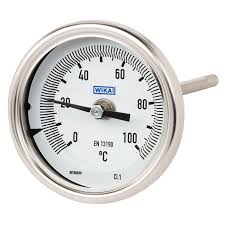Lorem ipsum dolor sit amet, consectetur adipiscing elit. Ut elit tellus, luctus nec ullamcorper mattis, pulvinar dapibus leo.
Temperature gauges are instruments used to measure the temperature of gases, liquids, or solids in various applications. They provide a visual indication of the temperature and are essential for monitoring and controlling temperature-sensitive processes. Here are some common types of temperature gauges:
1. Liquid-in-Glass Thermometers: These traditional temperature gauges consist of a glass tube filled with a liquid (usually mercury or alcohol). As the temperature changes, the liquid expands or contracts, causing it to rise or fall in the capillary tube, providing a reading on a calibrated scale.
2. Bimetallic Thermometers: Bimetallic temperature gauges consist of two metal strips with different coefficients of thermal expansion, bonded together. As the temperature changes, the two strips bend in opposite directions, resulting in a deflection that moves a pointer on a scale.
3. Gas Thermometers: Gas thermometers use a gas (often nitrogen or hydrogen) enclosed in a bulb connected to a capillary tube. As the gas expands or contracts with temperature changes, the pressure in the capillary tube changes, providing a temperature reading on a scale.
4. Resistance Temperature Detectors (RTDs): RTDs are temperature gauges that use the electrical resistance of a metal (usually platinum) to measure temperature changes. As the temperature increases, the electrical resistance of the metal also changes, and this variation is used to determine the temperature.
5. Thermocouples: Thermocouples are temperature sensors consisting of two different metal wires joined at one end. When the junction is exposed to a temperature gradient, it generates a voltage proportional to the temperature difference, allowing the temperature to be measured.
6. Infrared (IR) Thermometers: Infrared thermometers measure temperature by detecting the infrared radiation emitted by an object. They are non-contact temperature gauges, making them suitable for measuring the temperature of moving objects or hazardous materials.
7. Thermistor Thermometers: Thermistors are temperature sensors made from temperature-sensitive semiconductors. Their electrical resistance changes significantly with temperature, allowing for accurate temperature measurements.
8. Digital Temperature Gauges: These temperature gauges use digital displays to provide temperature readings. They can incorporate various types of temperature sensors, such as RTDs, thermocouples, or thermistors.
The selection of a temperature gauge depends on the specific application, temperature range, accuracy requirements, response time, and environmental conditions. Each type of temperature gauge has its advantages and limitations, making it suitable for different applications in industries such as manufacturing, HVAC, food processing, healthcare, and more.
